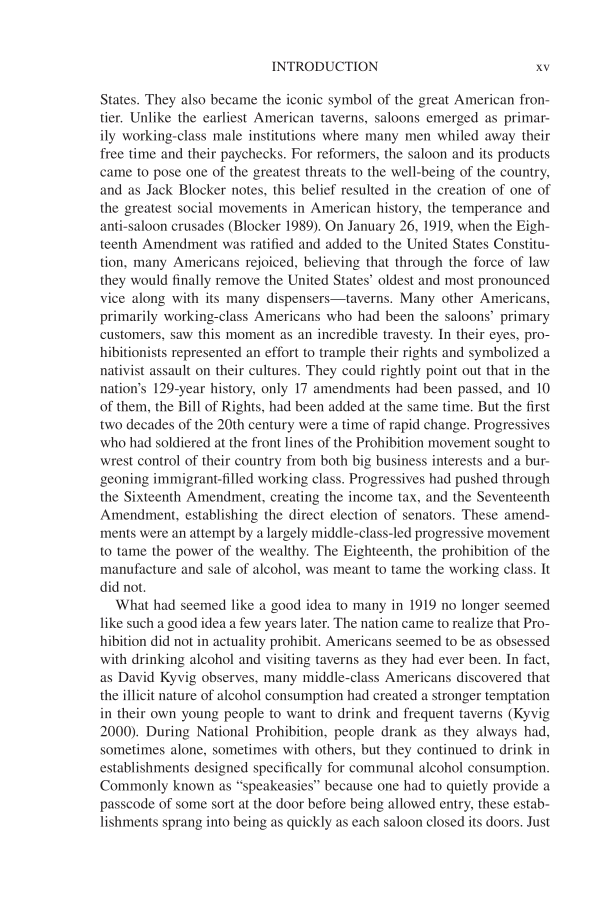Introduction xv States. They also became the iconic symbol of the great American fron- tier. Unlike the earliest American taverns, saloons emerged as primar- ily working-class male institutions where many men whiled away their free time and their paychecks. For reformers, the saloon and its products came to pose one of the greatest threats to the well-being of the country, and as Jack Blocker notes, this belief resulted in the creation of one of the greatest social movements in American history, the temperance and anti-saloon crusades (Blocker 1989). On January 26, 1919, when the Eigh- teenth Amendment was ratified and added to the United States Constitu- tion, many Americans rejoiced, believing that through the force of law they would finally remove the United States’ oldest and most pronounced vice along with its many dispensers—taverns. Many other Americans, primarily working-class Americans who had been the saloons’ primary customers, saw this moment as an incredible travesty. In their eyes, pro- hibitionists represented an effort to trample their rights and symbolized a nativist assault on their cultures. They could rightly point out that in the nation’s 129-year history, only 17 amendments had been passed, and 10 of them, the Bill of Rights, had been added at the same time. But the first two decades of the 20th century were a time of rapid change. Progressives who had soldiered at the front lines of the Prohibition movement sought to wrest control of their country from both big business interests and a bur- geoning immigrant-filled working class. Progressives had pushed through the Sixteenth Amendment, creating the income tax, and the Seventeenth Amendment, establishing the direct election of senators. These amend- ments were an attempt by a largely middle-class-led progressive movement to tame the power of the wealthy. The Eighteenth, the prohibition of the manufacture and sale of alcohol, was meant to tame the working class. It did not. What had seemed like a good idea to many in 1919 no longer seemed like such a good idea a few years later. The nation came to realize that Pro- hibition did not in actuality prohibit. Americans seemed to be as obsessed with drinking alcohol and visiting taverns as they had ever been. In fact, as David Kyvig observes, many middle-class Americans discovered that the illicit nature of alcohol consumption had created a stronger temptation in their own young people to want to drink and frequent taverns (Kyvig 2000). During National Prohibition, people drank as they always had, sometimes alone, sometimes with others, but they continued to drink in establishments designed specifically for communal alcohol consumption. Commonly known as “speakeasies” because one had to quietly provide a passcode of some sort at the door before being allowed entry, these estab- lishments sprang into being as quickly as each saloon closed its doors. Just
Document Details My Account Print multiple pages
Print
You have printed 0 times in the last 24 hours.
Your print count will reset on at .
You may print 0 more time(s) before then.
You may print a maximum of 0 pages at a time.






































































































































































































